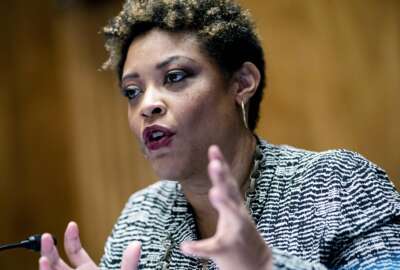They have their plans, can federal agencies follow through on equity?
Not since the Civil Rights Movement have we seen such a large concentration of executive branch directives around diversity, equity and inclusion issued at once,...
Not since the Civil Rights Movement of the 1950s and ’60s have we seen such a large concentration of executive branch directives around diversity, equity and inclusion issued at once. They range from the broad, like President Joe Biden’s executive order 13985, to the incredibly specific, like the General Services Administration’s planned 14 civil rights compliance reviews of state agencies for surplus property in fiscal 2022-2026, and compliance reviews of the largest recipients of federal surplus personal property.
That second example comes from GSA’s Equity Action Plan, one of more than 90 issued by federal agencies this week. They encompass a combined total of 300 new actions to support underserved or marginalized groups including communities of color, women, LGBTQ+ communities, people with disabilities, tribes, rural and low income communities
Many of these efforts take funding, which is why Office of Management and Budget Director Shalanda Young said the president’s fiscal 2023 budget request includes investments in equity.
However, the Biden administration acknowledged in the plans’ announcement that equity is a generational commitment, not a one- or even five-year plan. And it’s not as if attempts to increase diversity, equity, inclusion and accessibility (DEIA) are anything new. Diversity and inclusion are challenges for all of federal government. They’re just more visible for some agencies, due to the nature of their missions, their size, or the publicity they receive.
Take the State Department as an example, which, aside from the military, is perhaps the federal agency most known for physically representing America across the world. Diplomacy and cultural exchange are core facets of State’s mission, so how can it have a diversity and inclusion problem?
Well for one thing, State has a history of excluding minorities from employment and senior positions despite several policy attempts to diversify its workforce. Fast forward to the present, it’s also received scrutiny for what some consider a passive kind of discrimination. This month, social media users and the Atlanta Black Star news site brought attention to the Peace Corps’ guidance for nonwhite volunteers working in Ukraine. The guidance specifically warns that racial and ethnic minorities face a higher risk of discrimination in the Eastern European country than whites, but offers little direct support or path of recourse for those impacted.
Supporting a diverse workforce requires different assistance for unique needs or experiences. Two people can have the same position, duties and deployment but the external factors of their environment can produce dramatically different results for those employees, and State should account for that.
When the department’s Chief Diversity and Inclusion Officer Gina Abercrombie-Winstanley was sworn into her role just over a year ago, Secretary of State Antony Blinken said at the ceremony, “We’ve got our work cut out for us. The State Department simply isn’t as diverse and inclusive as it needs to be.”
He referenced a Government Accountability Office report the previous year which found that the overall proportion of racial or ethnic minorities in State’s full-time, permanent, career workforce increased from 28% to 32% from fiscal 2002 to 2018, but the proportion of racial or ethnic minorities and women was lowest at management and executive levels. Minorities in State’s Civil Service were 4% to 29% less likely to be promoted than their white coworkers with similar education, occupation or years of federal service.
As CDIO, Abercrombie-Winstanley, the former ambassador to Malta and former diplomat who has served all around the world, has the job of leading the effort to build a department “that looks like the America it represents.” It’s easier said than done.
In her testimony at a June 2020 hearing of the House Committee on Foreign Affairs’ Subcommittee on Oversight and Investigations, she bluntly stated that she was proud of her 32 years in Foreign Service, “But I am not proud of how the Department of State has hindered, undervalued, demoralized and destroyed the dreams of some of her best and brightest because of bias, racism and quiet discrimination.”
Abercrombie-Winstanley said State needed to incentivize inclusion in promotion and leadership positions, that it did not rate performance on employees’ ability to raise up underrepresented officers, expand the diversity of viewpoints and backgrounds in decisionmaking, or their ability to make their respective bureau, embassy, office or section more inclusive.
A month before her appointment, the Truman Center released a report she co-chaired, containing “candid feedback from career diplomats on the frontlines,” including mid-level officers from both the Civil and Foreign Service and across underrepresented groups. Among its many recommendations were the creation of a powerful and clearly defined, under Secretary-level chief diversity and inclusion officer, to whom every bureau would report via a senior adviser (FS-01 or higher) for diversity and inclusion.
For now at least, one more State agency can cross this step off its list.
Neneh Diallo was sworn in as the first-ever chief diversity officer at the U.S. Agency for International Development on March 16. USAID Administrator Samantha Power said at the ceremony that elevating the CDO role to the front office and uniting all disparate DEIA efforts behind one leader was about more than just changing the agency’s appearance.
“It’s about changing how it feels to work here, elevating a far more inclusive array of voices and making sure they have seats at the table, and grappling with the legacies of racism and sexism that plague all institutions in this country,” Power said.
Per the Biden administration’s DEIA executive order, all agencies had to submit a DEIA strategy to OPM last month. The EO did not require agencies to make those strategies publicly available, and although USAID wrote a DEIA plan in 2020 only the strategy’s executive summary is searchable on the agency’s website. Past attempts to increase USAID’s diversity produced mixed results: Another GAO study of USAID staff from 2002-2018 found that the overall proportion of racial or ethnic minorities in the full-time, permanent, career workforce rose from 33% to 37%, but proportions of some groups decreased. Racial or ethnic minorities in the civil service were 31% to 41% less likely to be promoted than whites with similar jobs or years of service, the final report said in 2020. Staffing gaps and a lack of senior leadership attention were main reasons for USAID’s inability to meet EEO requirements.
As of this writing, GAO says USAID implemented all four of their recommendations.
Nearly Useless Factoid
Hippopotamus sweat includes a pigment that absorbs UV rays, functioning as a type of natural sunscreen.
Source: National Geographic
Copyright © 2025 Federal News Network. All rights reserved. This website is not intended for users located within the European Economic Area.
Amelia Brust is a digital editor at Federal News Network.
Follow @abrustWFED







